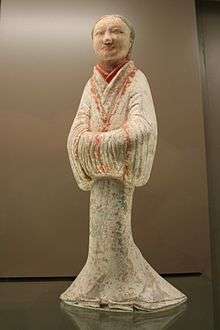Mingqi
Mingqi (Chinese: 冥器 or 明器, p míngqì), sometimes referred to as "spirit objects"[1] or "vessels for ghosts", are Chinese burial goods. They included daily utensils, musical instruments, weapons, armor, and intimate objects such as the deceased's cap, can and bamboo mat.[2] Mingqi also could include figurines, spiritual representations rather than real people,[3] of soldiers, servants, musicians, polo riders, houses, and horses.[4] Extensive use of mingqi during certain periods may either have been an attempt to preserve the image of ritual propriety by cutting costs, or it may have a new idea separating the realm of the dead from that of the living.[5]

Purpose
Mingqi served to provide the deceased with necessities and comforts in the afterlife. The deceased person's po was said to remain in the realm of the tomb while the hun ascended to heaven. To appease and make worthwhile the deceased's po, mingqi claimed relevant and liked by the deceased were placed in his tomb. Upon placing mingqi in the tomb, humans, according to the Confucian ideal, were harmonizing the cosmos by striking a balance for the comfort of the deceased who is also comforted in heaven.[6]
See also
- Joss offerings, also referred to as mingqi
- Hell money
- hun and po, components of the spirit
in ancient Chinese religion
References
- Loewe, p. 266
- Loewe, Michael; Shaughnessy, Edward L. (1999). The Cambridge history of ancient China: from the origins of civilization to 221 B.C. Cambridge University Press. pp. 728–. ISBN 978-0-521-47030-8. Retrieved 26 January 2011.
- Higham, Charles (2004). Encyclopedia of ancient Asian civilizations. Infobase Publishing. pp. 224–. ISBN 978-0-8160-4640-9. Retrieved 26 January 2011.
- Rotary International (January 1994). The Rotarian. Rotary International. pp. 23–. ISSN 0035-838X. Retrieved 26 January 2011.
- Stark, Miriam T. (2006). Archaeology of Asia. Wiley-Blackwell. pp. 212–. ISBN 978-1-4051-0213-1. Retrieved 26 January 2011.
- Clydesdale, Heather Colburn. "The Vibrant Role of Mingqi in Early Chinese Burials". Heilbrunn Timeline of Art History. The Metropolitan Museum of Art. Retrieved 8 August 2012.
| Wikimedia Commons has media related to Mingqi. |